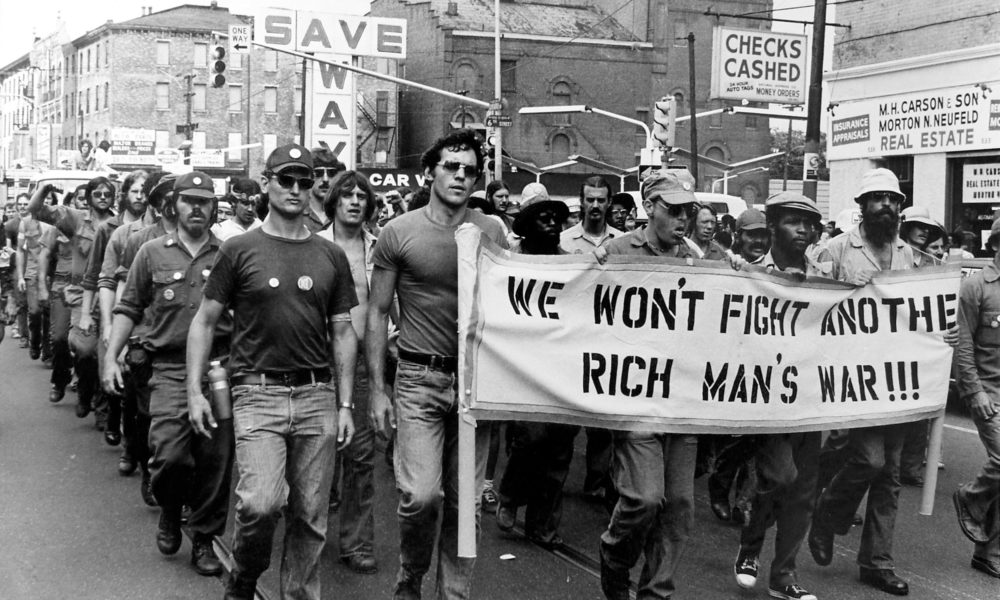The US’s assassination of Qasem Soleimani last week is a clear demonstration that the US has no intentions of ever pulling out of the Middle East. If we wish to avoid further conflict in the region, we must build an anti-war movement as strong and determined as the one that helped end the Vietnam War.

As bourgeois politicians and news outlets quibble over the logistics of a new war in the Middle East, people in the United States are taking to the streets to say “no.” These protesters understand that another war in the Middle East does not mean stability in the region or defending the interests of the majority of Americans. They know another war means only increased US military presence in the region to ensure access to lucrative resources, US interference in Iranian politics, soaring profits in the defense industry, and of course, the deaths of thousands of people. In cities across the country, various groups have already called demonstrations in opposition to Trump’s attacks and are calling on bourgeois politicians, mostly within the Democratic Party, to oppose any further acts of aggression in the Middle East.
But if these demonstrations truly wish to prevent a war with Iran, resist Trump’s policies, and end the imperialist attacks, then we must realize that we cannot rely on the politicians in Congress to oppose the war. While Democrats have spoken out against the attack, they have done so largely for procedural and economic reasons. Nancy Pelosi, for instance, has decried the fact that Trump did not seek congressional approval for the attack, while Elizabeth Warren claims the money for such military actions could be better spent elsewhere. Unsurprisingly, neither spoke out against US imperialism or political and military interventionism in the region. On the contrary, all the Democratic candidates declared themselves in favor of keeping troops in Syria. Nor should it be forgotten that troops were deployed to Iraq and Afghanistan under the Obama administration, who earned the nickname “King of Drones” for implementing drone bombings. The Democrats have no issue with extrajudicial killings or even a war with Iran—they simply oppose Trump’s unilateral decision-making and worry for US capitalist interests in the region.
Only a movement independent of both imperialist parties, one which is led by the working class and young people who ultimately suffer the consequences of bourgeois wars, can possibly put a stop to such acts of aggression and put a dent in a pillar of 21st-century US imperialism. The United States has a legacy of an anti-war movement—it’s time to revive it.
A Return to 2003?
With the devastating consequences of the Iraq War fresh in the minds of many people in the US, the recent escalation of the conflict in Iraq seems terrifyingly familiar. The protracted wars in the Middle East have killed upwards of 600,000 Iraqis by conservative estimates and destabilized the region, leaving it open to imperialist plunder for years to come. But it is important to remember that this destruction did not unfold without significant resistance from the working class and young people in the United States and around the world. The anti-war demonstrations against George W. Bush, the invasion of Afghanistan, and the Iraq War that took place in the early 2000s are instructive for those who today demand an end to Trump’s imperialist attacks against Iran and Iraq and the expulsion of American troops from the Middle East.
On February 15, 2003, upwards of 500,000 people took to the streets outside the United Nations headquarters in New York City to protest Bush’s plans to invade Iraq. Other activists staged protests in cities across the country. They were joined by labor unions, environmental groups, and progressive organizations. Coordinated protests around the world occurred simultaneously, marking an international day of action against US war-mongering.
Despite this public outcry, only 30 days later, the Bush administration, with the near unanimous support of Democrats and Republicans alike, sanctioned the invasion of Iraq, beginning a nearly decade-long conflict that wreaked havoc on the region. Anti-war protests continued in response to the invasion, bringing hundreds of thousands of people into political action over the years. Most notably, on May 1st, 2008, ten thousand workers of the International Longshore and Warehouse Union (ILWU) walked off the docks to demand the withdrawal of US military forces from Iraq and Afghanistan.
Aside from this example, however, the links between the anti-war movement and the labor movement in the US were tenuous, and certainly too weak to organize mass strikes against the Iraq war. An anti-war movement that hopes to throw a wrench into the capitalist war machine must fight its battles on the field of class struggle—uniting the labor movement and the anti-war movement and implementing strikes, work stoppages, and demonstrations to force the war hawks on Capitol Hill to end military interference abroad. This is the kind of anti-war movement we should strive to build today as Donald Trump and Mike Pompeo fan the flames of war over social media.
Unlike today, the Iraq War and the broader “War on Terror” enjoyed widespread popular and political support in the wake of 9/11. Today, after the revelations of the countless lies that the Bush administration and the bourgeois political apparatus as a whole told the public to prolong intervention in Iraq and Afghanistan, this consensus no longer holds true. Aside from Trump’s own unpopularity, an entire generation of Americans has been disillusioned by the experience of the Iraq War and is resistant to the idea of another war in the Middle East. This opens up a space for the Left in the US to take the lead in organizing an anti-war, anti-imperialist movement that unites the anti-war movement with the labor movement and social movements more broadly, a combination that can confront the US government’s military aspirations.
Moreover, unlike today when the influence of the US has suffered a prolonged period of degradation, in 2003 it was positioned as an established, albeit declining, global hegemon that enjoyed more economic, political, and military dominance. This made organizing an anti-war movement all the more difficult and limited the ability of that movement to reach broad sectors of US society; this ultimately forced the energy of the anti-war movement into the effort to elect Barack Obama in 2008. However, the anti-war movement hinted at the power that workers and young people have to challenge US imperialism and has set the stage for a new anti-war movement today.
Obama Killed the Anti-War Movement
Obama’s 2008 election, and the campaign around it generated massive expectations. After all, he promised to get troops out of Iraq and Afghanistan and to build a foreign policy based on diplomacy rather than brute force. After eight years of Bush-Cheney war-mongering, Obama’s promises to end the wars were among the issues that brought him into the White House. Some progressives concluded that protests were ineffective to stop the war—it was time to vote for change. Thousands of anti-war protesters believed in Obama’s hope and change, and that a vote for him could be a tactic in the anti-war movement.
But Obama’s presidency was a vastly different story. He didn’t take troops out of Iraq or Afghanistan. In 2014 he deployed US special-operations forces to 133 countries: 70 % of the world. Under Obama, the US military allocated more money to war than Bush ($866 billion under Obama vs. 811 billion under Bush). He also moved troops into more countries than Bush, including Nigeria, Libya and Somalia—and so, although less troops were mobilized, the United States was involved in more countries under Obama. And then there were the drone strikes—which occurred much more frequently than under Bush’s administration.
As Michael T. Heaney and Fabio Rojas argue in Party in the Street: The Anti-War Movement and the Democratic Party after 9/11, participation in the anti-war movement dropped drastically by 2008; even the number of articles about the conflict in the bourgeois media plummeted.
The book finds that it wasn’t that anti-war activists had moved on or had suddenly became pro-war; rather, they “trusted Obama to do what was right to remedy the situation.” In this sense, as the text argues, it was “demobilization not in response to a policy victory, but in response to a party victory.” But it was not only a party victory that demobilized the movement; it was also specifically Obama’s victory and illusions in the hope and change he promised to people living in the United States.
Those of us who are against a possible war in Iran and who want troops out of the Middle East have lessons to learn from this. We can’t trust Democratic politicians, including even “progressives” like Bernie Sanders or Elizabeth Warren to end the war. We can’t trust Congress to not declare war in Iran—and we can’t trust Sanders’ plan to pass legislation blocking funding for a war in Iran. The Democrats and Republicans are pro-imperialist parties and when push comes to shove, are both in favor of war, drones and coups. This time, the anti-war movement shouldn’t make the same mistake of trusting the fight against wars to politicians—we need to be in the streets. Luckily, there is a legacy of this in the United States, one that we must bring back if we are to challenge this latest intervention in the Middle East by Donald Trump.
You may be interested in: There Is No Right Way to Launch an Imperialist Attack
Bring Back the Spirit of the Vietnam War
The United States has a legacy of a combative anti-war movement, one that paved the way for the defeat of US imperialism in Vietnam. Hundreds of thousands of young people across the US mobilized in the streets and on college campuses demanding an end to the war in Vietnam—demanding “Vietnam for Vietnamese” and the US out of Vietnam. Hundreds of thousands of youth dodged the draft, with some going to jail for refusing to join the military to kill Vietnamese. Slogans such as: “We Won’t Fight Another Rich Man’s War,” and among Black folks, “No Vietnamese Ever Called Me Ni***er,” were popular. It was an anti-war movement that had martyrs in the Kent State Massacre, where the National Guard brutally repressed student protesters. Even veterans joined the movement, speaking out against their own armed forces.
While we cannot underestimate the weight that the draft had in creating such a radicalized anti-war movement, it isn’t the sole explanation. The peak of the anti-Vietnam war movement took place in 1969—and this should come as no surprise. It was a year after the massive mobilizations of 1968 that shook the world: the student and worker general strike in France that became known as the French May, the student strike and occupation of the university of Mexico City, the workers councils in Chile and Argentina, and the left mobilizations against the Stalinist regime in Prague. In Vietnam, there was mass resistance against the US invasion, with civilians and soldiers fighting back heroically. It was a moment of uprising in the US as well—this period marked the height of the Black Panthers and the Young Lords; the Stonewall uprising had just taken place. Around the world, workers, young people, and oppressed people were rising up. They were questioning the powers that be and were willing to fight for something different.
Despite some important differences, it might be said that we are living a similar kind of moment today, making the moment ripe for an anti-war movement. In 2019, there were mass uprisings all over the world. Prime Ministers have been forced to resign. Austerity plans were brought down. There were general strikes and the working class and youth confronted the police all over the world. In the United States, there was a strike wave amongst teachers, and the first major industrial strike in decades at General Motors. Among young people, socialism is more popular than capitalism. We are a generation that is starting to rise up and wants a drastically different future.
In light of these attacks in Iran and the possibility of impending war, it is time to revive the spirit of the Vietnam War protests. It is time to get hundreds of thousands of youth and workers into the streets to demand that the US not go to war with Iran—and in fact, that it get out of the Middle East completely. It is time for working class people to say clearly: we won’t fight a rich man’s war, we won’t fight wars for oil and we won’t fight wars to kill working class people in other countries. Our enemies are at home. They are the capitalists who exploit us, the politicians who send working class people to die, and the cops who harass and kill people of color. In the spirit of the Vietnam War protests, we won’t trust the capitalist politicians and their back room deals in hopes that they will stop an impending war in Iran, or get the US out of the Middle East. That’s what Barack Obama promised. It’s what Donald Trump promised. But there are still 70,000 troops in the Middle East.
Reviving the spirit of the Vietnam War protests means taking the struggle to the streets. It means mass protests and rallies, following the example of the current protests in Chile. In that sense, it means shutting down production against the war, in the same way sectors of the working class in Chile have gone on strike against the government. And in this social and political context, it will be up to the new generation of people interested in socialism to build the foundations of an anti-war movement, connecting the fight against capitalism to the fight against the war machine that is so central to US capitalist profits. An essential part of this task is building a revolutionary organization that is led by workers, young people, and all those who bear the consequences of capitalists’ wars—an organization that is not subordinate to any bourgeois party and will not compromise when it comes to US imperialism.
Stopping a war with Iran will be no easy task. The United States is home to the most brutal imperialist power in the world. It is also home to one of the strongest anti-war movements in history, one that forced the world’s most powerful army to be defeated by the Vietnamese masses, despite having far less money and resources. The Vietnamese and the anti-war movement defeated the United States in Vietnam. It is time to do it again.









